We went along for a day to the AWE Europe event in Munich, mainly to get a chance to see the latest Varjo headset (covered in a DD last week). Of course, while we were there, we had a good look at all the other things that were at the Expo. We even found time to attend a couple of conference sessions on automotive topics.

The first company we got to talk to was Univet, which is an established maker of glasses and was showing its VisionR safety glasses. The glasses uses a monocular waveguide-based system to put an image in front of one eye. Now, other vendors explained that the safety-glasses certification mandates that no part of the field of view can be blocked and most companies get around this by positioning the imager outside the main vision field, either temporarily or permanently. The VisionR glasses use a different approach – they make the waveguide ‘completely’ transparent.
We queried this. “Surely there is some loss?” It turns out that there is some loss, but much less than the 10% or 12% typically lost in regular spectacles. The waveguide and optical engine comes from Sony and is based on LCD technology. Resolution was low at just 419 x 135 and the image was monochrome, but it was centred in the glasses.
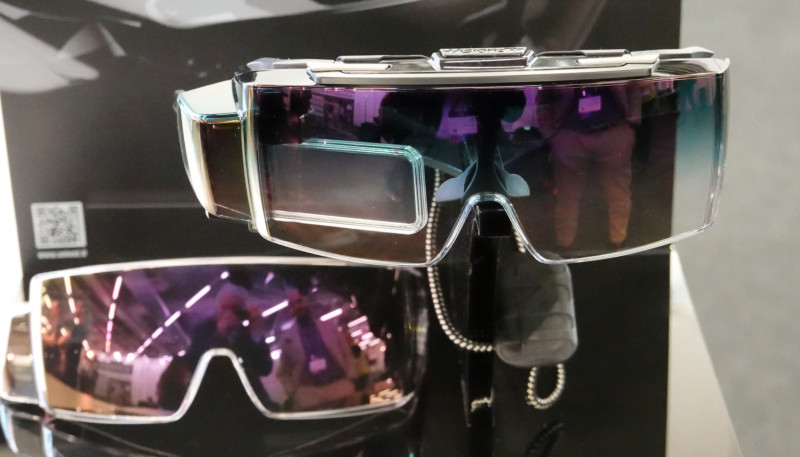 Click for higher resolution. Image:meko
Click for higher resolution. Image:meko
The design of the glasses was based originally on medical glasses and have a range of optional lenses available, including tinted, darkened, photochromic and other options if the glasses are to be used in intensely bright areas, where the image might not be very visible. The glasses are approved to ANSI 287.1+ which means they are approved for high impact protection. Staff told us that they are robust enough to be used for military applications and admitted that they are developing a military use optimised version. They also emphasised the .1 part of the specification as being ‘true safety glasses’. The glasses are designed to run from any Linux, Android or Windows system (but not iOS) via a USB Type-C connection and the firm has a deal with Toshiba to allow the supply of its rugged micro PC for AR/VR.
Production of the VisionR glasses started a few months ago.
Iristick was the second company we talked to about safety glasses. The company is based in Antwerp, Belgium and is a privately-funded start-up that has received funding under the EU Horizon scheme. They had a different approach to Univet, and were using a Kopin 428 x 240 (WQVGA) colour display that is mounted up and to the side of the glasses, so that they do not block normal vision. They can also be pushed up out of the way of normal vision completely. The optical design is intended to deliver the equivalent of an A3 image, focused at 2m, to avoid the need for close focusing, which can be tiring.
As well as the display, there is an integrated camera, a laser pointer, LED flash and audio and the dedicated battery unit is separate. It has a USB Type-C connector and ‘any smartphone’ can be used to drive the glasses. hey have their own SDK for developing custom apps to take advantage of the camera etc. There are three versions of the glasses, listing from €1,600 to €2,200.
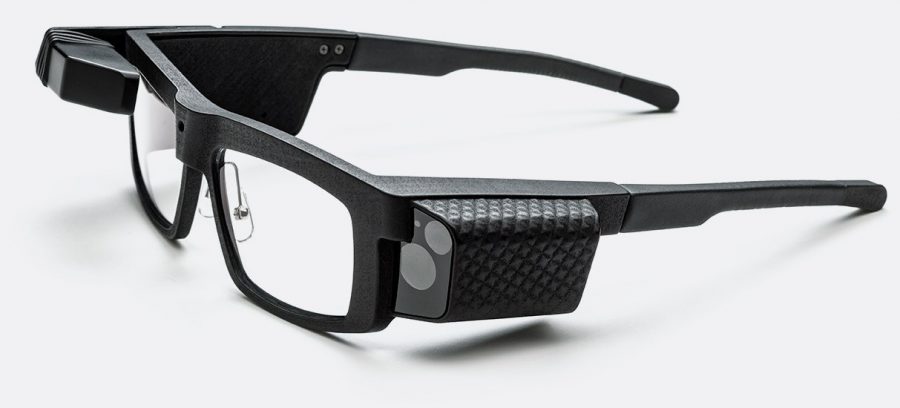 The Iristick safety glasses
The Iristick safety glasses
Vuzix was at the show and we had a brief chat with Paul Travers, CEO and founder of the firm and a regular at trade shows. He told us that the M400 HMD which it has been showing for some time, is now in limited production. However, “If you need 1,000 for a project, you’d better get your order in quick!”. It looks really good and he told us that it was ‘spectacular with video’. It’s based on a Sony microOLED.
Realwear had quite a big booth. The company, which was set up to develop a headset when Kopin decided not to further promote it (at least, that’s what Realwear says) was showing with partners and still has the original design hardware, so there was nothing new for us to report.
Kiber was another new name for us. The company is based in Pisa, Italy and developed out of the local university. It is making a complete hardware and software solution for A/R using its own dual (but with the same image) display unit, a thermal and optical camera and audio. The system has been developed ‘with users’ rather than from a design studio and has been optimised for remote assistance applications. The design is currently at V2.0, but V3.0 is under development.
Kiber has an unusual business model, renting the systems at €1,000 per month over two years for the full system or €550 per month for a cut down version, including licences and support. They believe that this is more realistic than selling them as, in two year’s time, they will have systems that are much better and users would want to upgrade.
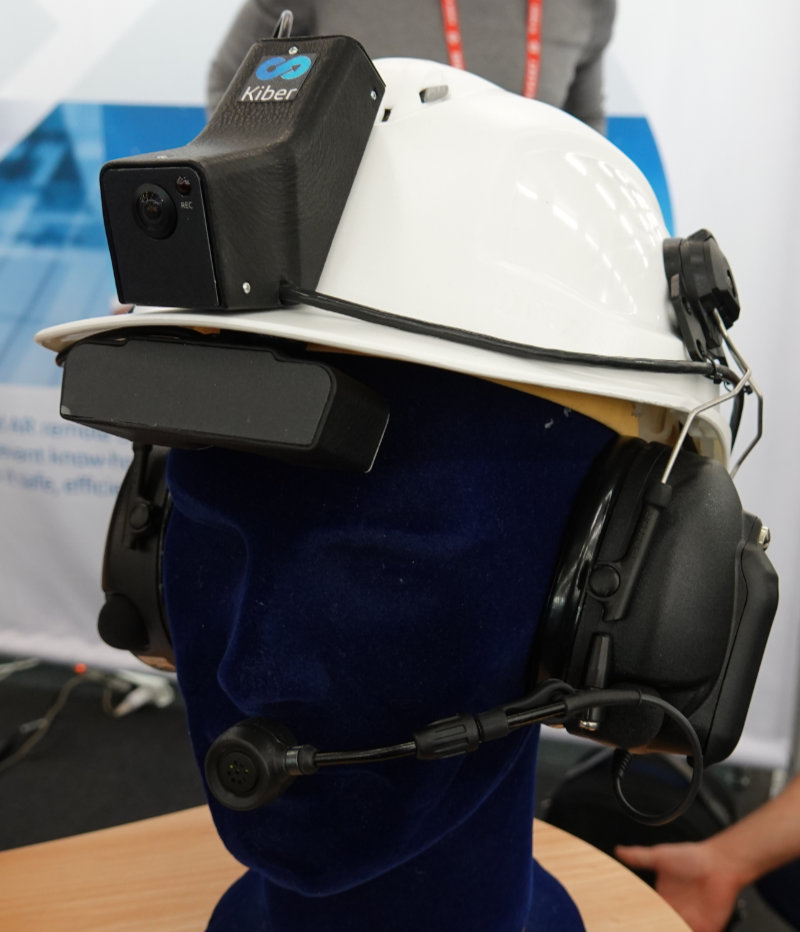 Kiber’s system. Click for higher resolution. Image:Meko
Kiber’s system. Click for higher resolution. Image:Meko
We last saw Schneider Digital at Laval Virtual a couple of years ago. The company makes displays using dual LCD monitors with a beam splitter and eye-tracking to optimise the view. The latest developments include support for UltraHD monitors up to 28″ (the most popular choice). The displays uses passive glasses and the latest version has ‘dots’ to allow very accurate tracking of the viewer’s orientation and direction to optimise the view.
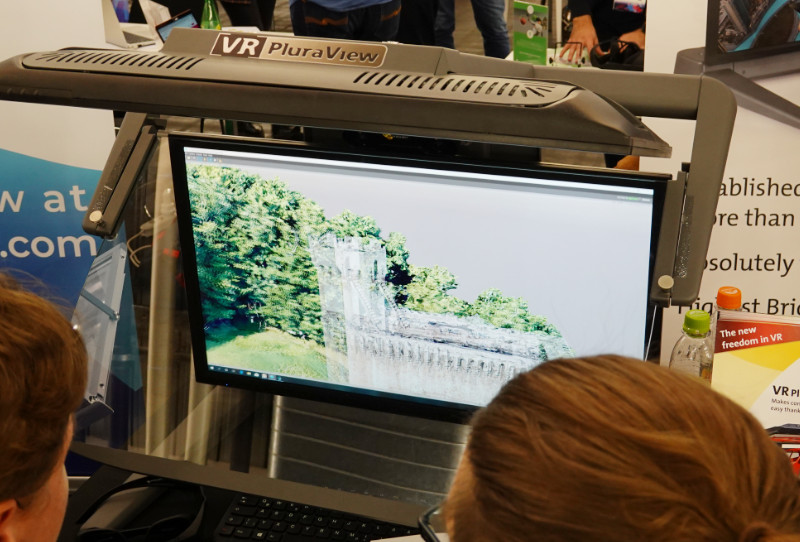
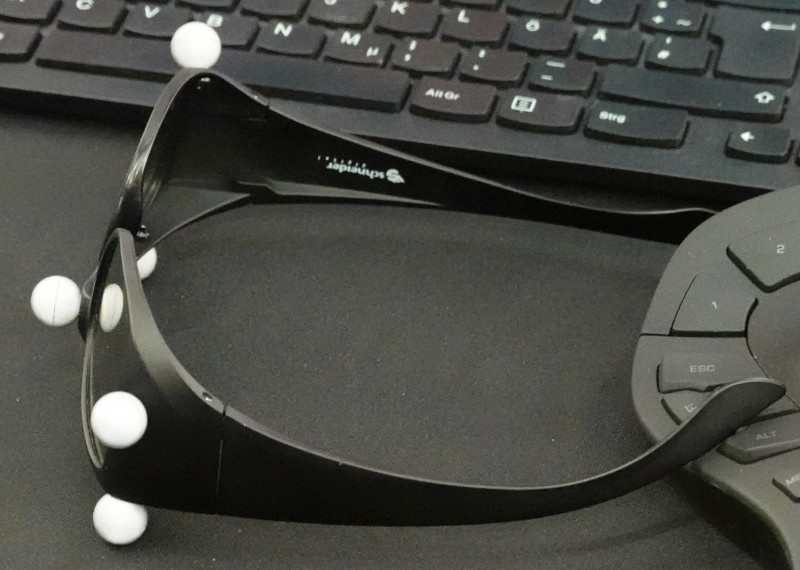
On the topic of stereo3D, we heard from someone at the show that Nvidia plans to drop support for shutter glasses from future versions of its graphics cards. That will cause dismay in some quarters!
Adding to the list of companies that are new names to us was Dispelix, a 42-strong start up (with 70% of staff in photonics) that has a new see-through waveguide that, unlike others that we have seen, comprises a single glass layer, rather than the three that are normally required for full colour operation. So, what is the secret? Staff on the booth told us that one of the keys was ‘massive computation’ in the optical modelling – the models that the firm has built to optimise its optics use 10,000 CPUs at a time! The second key was material choice. The thickness of the main waveguide is 0.8mm with a cover of 0.3mm. Allowing for an airgap, that means a thickness of 1.3mm.
Dispelix has a small production facility that can make a prototype in just three weeks, but is working with a partner for volume manufacturing. At the moment, it can make ‘hundreds per month’ but this will rise to 10K/month by the second half of 2020.
The field of view of the prototype on display was around 30 degrees diagonally on a 16:9 aspect ratio. The target market is AR glasses and the company told us that ‘any’ FOV is possible with the technology.
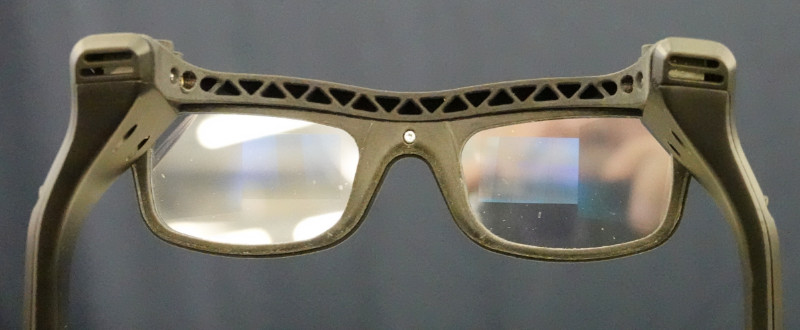 You can see the Dispelix single layer waveguide in this sample. Image:Meko. Click for higher resolution
You can see the Dispelix single layer waveguide in this sample. Image:Meko. Click for higher resolution
My friend and regular commenter on DD articles, Alfred Poor, has a view that ‘Any display described as holographic, never is’. Until today, he has been right. However, VividQ, a start-up with technology in Cambridge, UK, and a commercial operation in London, has developed a system for generating genuinely holographic images using spatial light modulators based on LCOS technology for HMDs and HUDs. There were no displays on show, but a video showing that an image with real depth could be generated using the techniques was being shown. At the show, the company announced a collaboration with Himax, the supplier of the displays for the Hololens. Now, making holographic images is tricky, but making them in real time is the company’s ‘secret sauce’. That ability has attracted a lot of interest from automotive companies that would like to have holographic HUD displays.
Currently the firm’s algorithms are being run on GPUs, but ASICs are really the way to go for optimum performance. The firm told us that it hopes to have a practical ‘real-world’ application of the technology by early 2021.
Check here for a video.
Finally, on the show floor, Lenovo was showing its new ThinkReality mixed reality display and procession unit which has just become available for developers and is based on the Qualcomm Snapdragon 845 processor running Android to create a stand-alone system. The headset includes dual fish-eye monochrome cameras for location and an RGB camera. The software to develop applications is the Unity engine, and any Unity app should run, we were told. General availability is the end of the year with pricing tbd. The unit we tried was a bit ‘glitchy’ and I found it a bit heavy on the nose, but no doubt there are enthusiasts that would be happy to wear it for extended periods.
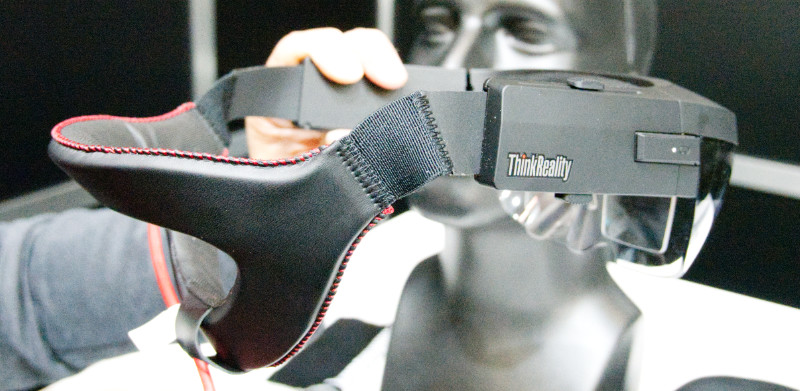 Lenovo’s Think Reality headset. Image:Meko. Click for higher resolution.
Lenovo’s Think Reality headset. Image:Meko. Click for higher resolution.
(Actually, at the very end of the ‘happy hour’, somebody mentioned a company that I had missed that had just a table. They were interesting, but I’ll come back to them, later).

